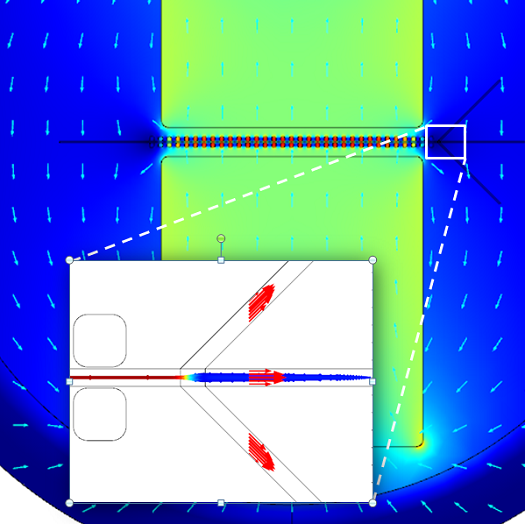Before conducting certain blood sample analyses, researchers need to separate the red blood cell particles from the blood plasma. Using lab-on-a-chip (LOC) technology, red blood cell separation can be achieved via magnetophoresis, i.e. motion induced by magnetic fields. Since the magnetic permeability of the particles is different from the blood plasma, their trajectory can be controlled within the flow channel of the LOC device and thereby separated out from the fluid.
Blood Plasma and Red Blood Cells
Whole blood consists of red and white blood cells, as well as platelets suspended in a liquid referred to as blood plasma. According to the American Red Cross, plasma is 92% water and makes up 55% of blood volume. The permeability of blood plasma is equal to 1.
Red blood cells make up slightly lower blood volume than blood plasma — about 45% of whole blood. As you probably already know, these types of blood cells contain hemoglobin, which in turn consists of iron that helps transport oxygen throughout the body. The permeability of red blood cells is slightly less than 1, (1 – 3.9e-6). Or to put it in words, red blood cell particles are diamagnetic.
Red Blood Cell Separation via Magnetophoresis in LOCs
Lab-on-a-chip devices (LOCs) are very small (picture an area in the millimeter-centimeter range) microfluidic devices consisting of flow channels that perform one or more lab functions on a single chip. LOCs are frequently used in medicine and research for analyzing samples of blood, thanks to the reduced risk of sample contamination made possible by the ability to collect and study very small samples.
Due to their aforementioned magnetic properties, red blood cells may be separated from the plasma via a magnetophoretic approach. If we were to subject the LOC channel to a magnetophoretic force, we could control where the red blood cells and the plasma go within the channels. In other words, because the red blood cells have different permeability, they can be separated from the flow channel.
Suppose we have an LOC containing blood plasma (in this case that’s considered the background fluid) and red blood cell particles in a channel that splits into three branches, or outlets (see image below). The drag force of the background fluid pushes the particles forward along the flow channel. Now suppose we have a permanent magnet on each side of the channel, as such:

LOC: Two neodymium permanent magnets and a flow
channel with three outlets and an array of soft iron patches.
The magnetophoretic force of the magnets will push the blood cell particles inward. Combined, the drag force and the magnetophoretic force will simultaneously push the particles toward the center and through the main channel, bypassing the two channel branches. Meanwhile, the blood plasma, which, as mentioned above, has a permeability of 1, is not affected by the magnetic field and simply travels along in the direction of the drag force. This ultimately leads one third of the plasma to flow through each of the channels, while all of the red blood cells are concentrated in the center channel — providing us with a high enough concentration to study.
My colleague John Dunec has created a multiphysics simulation to illustrate the concept:

Red blood cell separation: An LOC device, zooming in on the flow channels. The red blood
cell particles travel in the center channel.
The above simulation was created with COMSOL Multiphysics together with the AC/DC, Microfluidics, and Particle Tracing modules. A tutorial on how to run this on your own can be found in the section below.
Further Reading
- Tutorial: “Red Blood Cell Separation“
- Paper and Presentation: “Design and Simulation of a Microscale Magnetophoretic Device for the Separation of Nucleated Fetal Red Blood Cells from Maternal Blood“
- Paper and Presentation: “Simulation of a Magnetophoretic Device for the Separation of Colloidal Particles in Magnetic Fluids“